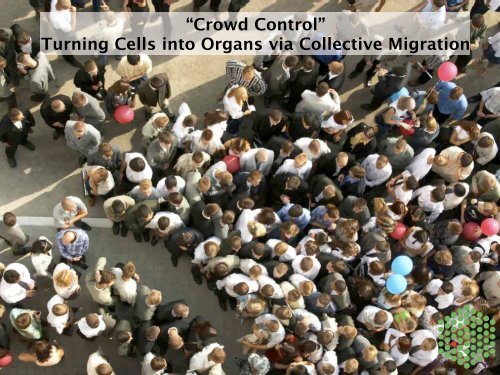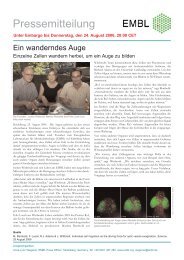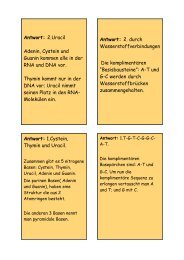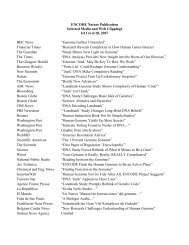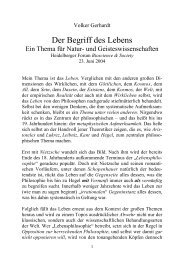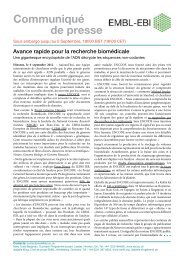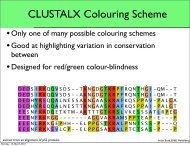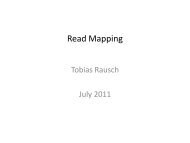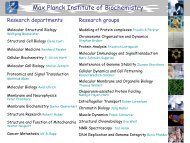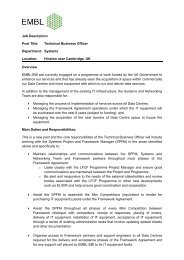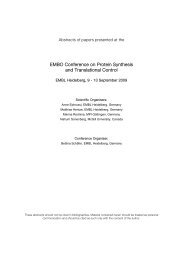“Crowd Control” Turning Cells into Organs via Collective Migration
“Crowd Control” Turning Cells into Organs via Collective Migration
“Crowd Control” Turning Cells into Organs via Collective Migration
You also want an ePaper? Increase the reach of your titles
YUMPU automatically turns print PDFs into web optimized ePapers that Google loves.
<strong>“Crowd</strong> <strong>Control”</strong><br />
<strong>Turning</strong> <strong>Cells</strong> <strong>into</strong> <strong>Organs</strong> <strong>via</strong> <strong>Collective</strong> <strong>Migration</strong>
What is developmental biology?<br />
Developmental Biology tries to answer the first scientific question that many<br />
children ask……..<br />
Where do BABIES come from?
Morphogenesis: “the origin of shape”<br />
Embryos are not made of<br />
homogeneous matter that is<br />
‘sculpted’ <strong>into</strong> shape
We are made out of cells<br />
Number of people on earth = 6 000 000 000<br />
Number of cells in a person = 10 000 000 000 000 000<br />
<strong>Cells</strong> come in many shapes and sizes for different func7ons<br />
Nerve <strong>Cells</strong>:<br />
transmit electrical signals<br />
Red Blood <strong>Cells</strong>:<br />
Carry oxygen<br />
Macrophages:<br />
Eat invaders/dying cells
http://multimedia.mcb.harvard.edu/
Subcellular-scale<br />
Morphogenesis<br />
Morphogenesis is process by which cells/tissues/organs are shaped.<br />
Shape depends on dynamic interactions at different scales.<br />
Cell-Scale<br />
Tissue-Scale<br />
Many tissues are shaped through the directed migration of constituent cells.<br />
Cell migration is a ‘shape’ problem that spans all three levels of scale.
Dicty movie from Firtel<br />
lab (UCSD)<br />
Single cells can navigate using graded chemical cues<br />
needle emitting<br />
chemoattractant<br />
(cAMP)<br />
How are migrating cells guided in vivo?<br />
Motile Cell<br />
(D.discoideum)
<strong>Cells</strong> in their natural habitat prefer to migrate in groups<br />
Migrating collectives come in different forms - sheets, chains, clusters, branched networks.<br />
Most are considered to be chemotactic.<br />
Challenge: Demands visualisation and manipulation of dynamic cell behaviours in vivo.
Zebrafish allow the study of dynamic cell interactions in intact embryos<br />
Zebrafish<br />
4cm long, grown at high density.<br />
200-400 embryos/female/week (=1000s of embryos/day).<br />
Embryos completely transparent.<br />
Genetic, pharmacological and light-based manipulation.<br />
Kane & Karlstrom
Imaging cellular and molecular dynamics in living tissues<br />
GFP: Green Fluorescent Protein
What is it?<br />
The zebrafish lateral line: an in vivo model for collective migration<br />
Mechanosensory hair cell organs deposited by migrating epithelium (RG Harrison, 1906).<br />
lateral line in action (BBC Blue Planet)
What is it?<br />
The zebrafish lateral line: an in vivo model for collective migration<br />
Transgenic : mGFP fused to claudin B promoter (cldnb:gfp)<br />
Mechanosensory hair cell organs deposited by migrating epithelium (RG Harrison, 1906).<br />
Top view, 10x/0.25 NA<br />
frame every 4 mins<br />
multi-tasking - cells migrate, grow, divide, differentiate and change shape simultaneously.<br />
“Embryogenesis in a nutshell” or “An animal inside an animal”
<strong>Collective</strong> migration :<br />
a(nother) link between morphogenesis and cancer<br />
Zebrafish lateral line primordium<br />
- Migrating epithelium with invasive ‘tip’<br />
CXCR4b mRNA SDF1a mRNA<br />
Human mammary carcinoma (MCF-7)<br />
- Migrating epithelium with invasive ‘tip’<br />
(Friedl and Gilmour, Nature Reviews MCB 2009).<br />
Primordium guided by same chemokine-receptor (CXCR4-SDF1)* as many human tumors.<br />
*David et al 2002
Wild Wild Type Type<br />
(WT) (WT)<br />
How do signals control tissue migration?<br />
CXCR4/SDF1 signaling guides tissue migration<br />
Cxcr4/SDF1-deficient<br />
Cxcr4 Cxcr4<br />
mutant mutant<br />
Key Unkowns That Can Be Addressed<br />
How do guidance signals guide tissues?<br />
How is the response to cues regulated collectively?<br />
Do cells within groups guide each other? If so, how?<br />
Tissue guidance can be mediated non-autonomously by a few leader cells.<br />
wt cxcr4 mutant
Tissue Polarity/Directionality Requires Constant Cxcr4/SDF1 Signaling<br />
2 wt cells<br />
Ablate guiding tip<br />
change text to something<br />
more focussed on<br />
polarity/migration<br />
Tissue is unstable, quickly reverting to Cxcr4b mutant phenotype upon leader ablation.<br />
One Cxcr4b expressing cell is able to reverse tissue assembly and rescue migration.<br />
How does the chemokine path select and control leader cells?<br />
wt cxcr4 mutant
What determines the directionality of LL migration?<br />
SDF-1a mRNA<br />
SDF1a mRNA<br />
mcherrySDF1a<br />
SDF1a<br />
mcherrySDF1a
The primordium treats the stripe of SDF-1a as a “two way street”<br />
fused somites (fss)<br />
SDF1a<br />
SDF1a mRNA<br />
12% (27/226)<br />
Finding: SDF1 is unlikely to be present in a pre-patterned head-to-tail concentration gradient.<br />
Question: How do tissues ensure directional persistence in absence of gradients?<br />
Challenge: How can we see what the tissue ‘sees’?
Organ assembly is the biological function of the primordium<br />
Stable epithelium Migrating epithelium<br />
Mesenchyme<br />
Adhesion<br />
γTubulin-cherry cldnB-GFP<br />
How are organ assembly and migration coupled?<br />
Motility
FGF ‘foci’ nucleate epithelial organ formation<br />
FGF-10<br />
B<br />
CC<br />
FGF-deficient<br />
γTubulin-GFP membrane-cherry<br />
Polarity can be down and up regulated <strong>via</strong> manipulation of FGF-signaling<br />
D<br />
E<br />
+ FGF inhibitor<br />
F<br />
G<br />
fgfr1 gfp<br />
fgf3 gfp<br />
fgf10 fgf10 gfp gfp<br />
wt pea3 gfp fgf3-/-,fgf10-/- pea3 gfp<br />
wt pea3 fgf3-/-,fgf10-/-<br />
wt<br />
50µm<br />
H<br />
pea3 gfp<br />
200µm 200µm<br />
200µm 200µm<br />
pea3<br />
50µm<br />
pea3 gfp fgf3-/-,fgf10-/ pea3 gfp<br />
50µm<br />
50µm
FGF ‘foci’ nucleate epithelial organ formation<br />
FGF-10<br />
FGF-deficient<br />
Polarity can be tuned by genetic/chemical manipulation of FGF-signaling<br />
washout FGF inhibitor<br />
Preventing organ formation arrests directed migration.<br />
SU5402 ‘washout’<br />
side view
Testing role of tissue-scale polarity by targeted laser dissection<br />
epithelial<br />
Genetics reveals that subdivison of the tissue requires different signaling pathways.<br />
Pulsed “ laser knife”(Nd:YAGatl 1⁄4:355nm, 1.2 NA)<br />
mesechyme-like ‘leaders’<br />
EB1GFP labeled MTs
Testing role of tissue-scale polarity by targeted laser dissection<br />
epithelial<br />
Tissue is polarised in terms of migratory potential.<br />
mesechyme-like ‘leaders’<br />
70 70 uM uM<br />
Rosettes ‘melt’ after leader<br />
ablation.<br />
“leading edge+rosettes’<br />
configuration is highly robust.<br />
Enconsin-GFP
Mesenchymal Leaders + Epithelial Rosette = Directional Persistence<br />
Distance in microns<br />
100<br />
90<br />
80<br />
70<br />
60<br />
50<br />
40<br />
30<br />
20<br />
10<br />
0<br />
Mean displacement of cells in fragment including rosette<br />
Std<br />
Mean Displacement<br />
20 40 60 80 100 120 140 160<br />
Time in minutes<br />
MSD in microns 2 /minutes<br />
35<br />
30<br />
25<br />
20<br />
15<br />
10<br />
5<br />
0<br />
Mean square displacement of cells in fragment<br />
Std<br />
Mean square Displacement<br />
20 40 60 80 100 120 140 160<br />
Time in minutes<br />
SDF1
Gilmour Lab 2011<br />
Erika Donà<br />
Sevi Durdu<br />
Andreea Gruia<br />
Andreas Kunze<br />
Chrisoph Moehl<br />
Li-Kun Phng<br />
Céline Revenu<br />
Ulrike Schulze<br />
Sebastian Streichan<br />
Guillaume Valentin<br />
Former Lab<br />
Petra Haas*<br />
Ana Fernandez-Minan<br />
Gülcin Cakan<br />
Virginie Lecaudey<br />
Acknowledgements<br />
EMBL<br />
Lars Hufnagel*<br />
Ernst Stelzer<br />
Carsten Schultz<br />
EMBL ALMF<br />
Rainer Pepperkok<br />
Yury Belyaev<br />
Stefan Terjung<br />
Christian Tischer<br />
EMBL MACF<br />
Alan Sawyer<br />
Sabin Antony


